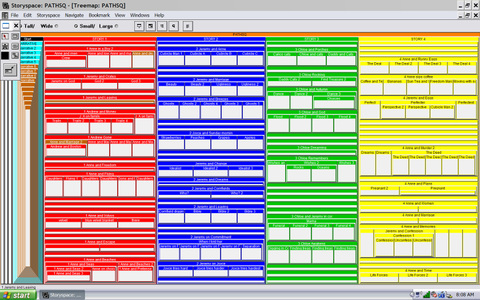‘Sfunny how the pure intent of creativity often blinds us to the support we can so readily base a work upon that still may be completely fresh and new and of ourselves.
Not blinded, but purposefully blindfolded, I avoided influence from sources that have not only traveled the roads, but built them. In rereading Mark Bernstein’s Patterns, this time without the stubborn resistance in place because well gee, I couldn’t put my finger on exactly what I needed to do to match what I wanted to do, I find that what has been done before is extremely useful. Even in placing labels and names such as Contour, Counterpoint, Joyce’s Cycle, etc. on the maneuvering of the paths tells me not only what I’m doing, but that there are more ways to get there, based on the experience of anyone else who’s written in hypertext. And, that there are more ways yet to be discovered.
Right now I think that what may get me where I’m going in Paths (and of course, the reader), is some use of Counterpoint and Mirror World. I suspected for a while now that I need to abandon the strong separation of the stories into their separate pathways, allowing them to link briefly at certain points. It’s easy enough to tell yourself that’s the way you want them to be read and the reader will be confused by the duplication of characters not only in time (that part’s easy–bellbottoms versus Dockers is obvious) but in choice (I won’t explain this one).
But in forcing the reader to follow one story out to the next to the next, it’s not creating a woven whole. In other words, I must establish a trail that brings them all together onto the narrative path. And while this may seem to be a more restricted flow of information, I think I’ve figured a way to present the story with all characters speaking at once, and yet allowing the reader to choose who to listen to for a while if they desire to do so.
And, it opens the story up to so much more than it already is; I see a more dramatic and revealing narrative of the lives of these people from Point A to Point B…or C or D or E – None of the Above.


 The Lost Children: A Charity Anthology
The Lost Children: A Charity Anthology